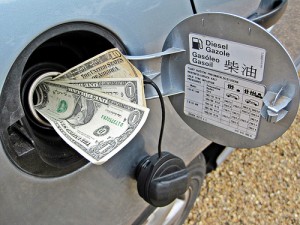 With gas prices pushing $4, I knew it was only a matter of time. And now it has finally happened. Our amazing gas rewards program will soon be no more.
With gas prices pushing $4, I knew it was only a matter of time. And now it has finally happened. Our amazing gas rewards program will soon be no more.
For the past 4 years, we’ve put all fuel purchases on a branded credit card. We always had to fill up at the same station, but in return, we received 5% cash back rebates for fuel purchases. I loved the cash back, and paying for gas in one bill every month simplified our budget, so it was win-win.
The letter we received outlined a new “rewards” program. It’s incredibly confusing, but from what I can gather, it seems like for every $100 we spend, we’re given the opportunity to fill up a single tank at a 15-cent-per-gallon discount. The discount accumulates with each $100 we spend. If we accumulate a $1-per-gallon discount (after spending $700 on gas), we can request a $15 statement credit. It shakes out to roughly 2% cash back if we continue to buy gas from this brand and choose the statement credit option.
The thing is, it’s not convenient for us to use this particular gas station anymore. When we first bought our house, the closest gas station happened to be this brand — it was literally right around the corner. Right around Christmas, though, the location suddenly closed. To keep getting our 5% rebate, I was driving clear across town every time I filled up. Without those rebates, it’s not worth the hassle.
We may eventually close the credit card. Since it’s not the first credit card for either one of us, it won’t shorten our credit history. As long as we increase our limits on other credit card accounts to account for the lost lending power, it should have minimal impact on our credit score. For now, though, I think we’ll just stop using it.
I still like the system of paying for gas in one lump sum every month, since that’s what we’re used to. I don’t want to open another credit card, though. So I started exploring my options.
There is another gas station around the corner from our house that offers a reward program. It’s a punch card, and we’ll receive a discount of 5 cents off per gallon for every 100 gallons we pump. I’ll take it!
Next I had to figure out which credit card to use. I looked at the rewards for the credit cards we currently have, and I wasn’t impressed. Each of them offered some kind of rewards program, but it’s one of those deals where you get a point per dollar, and then redeem 5,000 points for a $5 gift card or something. In other words, not a great deal.
There are other cards out there with better rewards, but that would require opening another credit card. So I did some more hunting, and found that American Express has a pretty decent cash rewards card with no annual fee that offers 2% cash back on gas. Since we already had an American Express card, I wondered if I could just switch my account to the cash rewards card without opening a new card. A quick phone call was all it took to make the switch. It’s obviously not as great as our flat 5%, but it’s the best deal I could find without opening a new account.
It’s about the same amount of money that we’d receive if we continued using our current card and bought gas from that brand. The benefit of switching is that we’ll get the reward for buying gas at any gas station, so we’ll have more freedom.
Our plan now is to put all gas purchases on the cash back card, and pay it off every month to avoid interest just like we’ve been doing all along, of course. (Remember: the rewards program isn’t worth it if you’re paying high interest rates or an annual fee.) We’ll also use the reward program at the gas station near our house for fill-ups at home. The bonus to this new system is that we’re no longer required to use the same gas station to get our rebate. This will make things much easier when we’re traveling since we won’t have to hunt for a certain gas station brand, and it will also allow us to price compare and fill up at cheaper stations.

